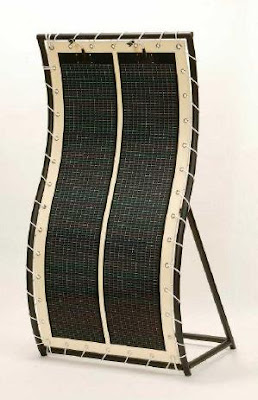
Sandia and Stirling Energy Systems set new world record for solar-to-grid conversion efficiency. The record establishes a new solar-to-grid conversion efficiency of 31.25 percent. The old record, which has stood since 1984, was 29.4 percent. (Photo by Randy Montoya)
http://www.nedo.go.jp/kankobutsu/report/1018/1018-09.pdf?nem NEDO海外レポート NO.1018, 2008.3.5
78
【エネルギー】太陽熱利用 スターリングエンジン
スターリングエンジンで太陽からグリッドへの変換効率
31.25%の世界新記録を達成(米国)
空がいつもより10%以上も明るい完全なニューメキシコの冬日に、サンディア国立研究
所とスターリングエネルギー・システム(SES)社は、太陽からグリッドシステムへの正味
効率で31.25%を達成し、新しい変換効率記録を塗り替えた。1984 年の効率29.4%の記録
は、サンディア国立研究所全米太陽熱試験施設にあるSES 社の「Serial#3」ソーラーディ
ッシュ形スターリングエンジンで2008 年1 月31 日に破られた。
この変換効率は、電力グリッドに送られた正味のエネルギーを測定し、皿形反射鏡を照
らす太陽エネルギーで割ることにより計算される。水ポンプ、コンピュータおよび追跡モ
ーターのような補助的負荷は、正味電力の測定で考慮されている。
「この型式のシステムにおける2 点の本質的な変換効率の向上は驚異的であった。これ
は、我々のディッシュエンジンシステムが、他のソーラーディッシュ集光器の能力をはる
かに越える大きな前進であり、そして手頃なシステムの商業化に一歩近づけた」とSES
社長兼CEO のブルース・オズボーンが述べる。
Serial#3 は、日中に150kW のグリッド対応電力を発電する太陽熱試験施設の6 ヵ所の
実証ディッシュモデル発電所の一部として2005 年5 月に組立てられた。各々のディッシ
ュ・ユニットは、太陽の光を強力なビームへ集光させるために、皿形に形成された82 個
の反射鏡から構成されている。
ソーラーディッシュは、スターリングエンジンに熱エネルギーを送る受光器上に太陽光
を集中させることにより電気を発電する。このエンジンは水素が充填された密閉方式であ
り、水素ガスは、加熱・冷却されるとき、その圧力は上昇・下降する。この圧力変化が、
スターリングエンジン内部のピストンを駆動し、機械エネルギーを発生させる。そして、
次に発電機を回して電力を発生する。
SES 社とサンディア国立研究所の共同でなされたシステムへのいくつかの技術的進歩
が、太陽からグリッドへの記録破りの変換効率ヘと導いた、とプロジェクトを統率するサ
ンディアプロジェクトエンジニアのチャック・アンドラーカは語る。
SES 社がディッシュおよび全てのハードウェアを所有している。サンディア国立研究所
は、10 年以上の長期にわたりSES 社に技術的・分析的支援をしている。
--(サンディア国立研究所ニュースリリース)-------------
http://www.sandia.gov/news/resources/releases/2008/solargrid.htmlNEWS RELEASES
FOR IMMEDIATE RELEASE
February 12, 2008
Sandia, Stirling Energy Systems set new world record for solar-to-grid conversion efficiency
31.25 percent efficiency rate topples 1984 record
ALBUQUERQUE, N.M. —On a perfect New Mexico winter day — with the sky almost 10 percent brighter than usual — Sandia National Laboratories and Stirling Energy Systems (SES) set a new solar-to-grid system conversion efficiency record by achieving a 31.25 percent net efficiency rate. The old 1984 record of 29.4 percent was toppled Jan. 31 on SES’s “Serial #3” solar dish Stirling system at Sandia’s National Solar Thermal Test Facility.
The conversion efficiency is calculated by measuring the net energy delivered to the grid and dividing it by the solar energy hitting the dish mirrors. Auxiliary loads, such as water pumps, computers and tracking motors, are accounted for in the net power measurement.
“Gaining two whole points of conversion efficiency in this type of system is phenomenal,” says Bruce Osborn, SES president and CEO. “This is a significant advancement that takes our dish engine systems well beyond the capacities of any other solar dish collectors and one step closer to commercializing an affordable system.”
Serial #3 was erected in May 2005 as part of a prototype six-dish model power plant at the Solar Thermal Test Facility that produces up to 150 kilowatts (kW) of grid-ready electrical power during the day. Each dish unit consists of 82 mirrors formed in a dish shape to focus the light to an intense beam.
The solar dish generates electricity by focusing the sun’s rays onto a receiver, which transmits the heat energy to a Stirling engine. The engine is a sealed system filled with hydrogen. As the gas heats and cools, its pressure rises and falls. The change in pressure drives the pistons inside the engine, producing mechanical power, which in turn drives a generator and makes electricity.
Lead Sandia project engineer Chuck Andraka says that several technical advancements to the systems made jointly by SES and Sandia led to the record-breaking solar-to-grid conversion efficiency. SES owns the dishes and all the hardware. Sandia provides technical and analytical support to SES in a relationship that dates back more than 10 years.
Sandia is a National Nuclear Security Administration laboratory.
Andraka says the first and probably most important advancement was improved optics. The Stirling dishes are made with a low iron glass with a silver backing that make them highly reflective —focusing as much as 94 percent of the incident sunlight to the engine package, where prior efforts reflected about 91 percent. The mirror facets, patented by Sandia and Paneltec Corp. of Lafayette, Colo., are highly accurate and have minimal imperfections in shape.
Both improvements allow for the loss-control aperture to be reduced to seven inches in diameter — meaning light is highly concentrated as it enters the receiver.
Other advancements to the solar dish-engine system that helped Sandia and SES beat the energy conversion record were a new, more effective radiator that also costs less to build and a new high-efficiency generator.
While all the enhancements led to a better system, one aspect made it happen on a beautiful New Mexico winter day — the weather.
“It was a ‘perfect storm’ of sorts,” Andraka says. “We set the record on Jan. 31, a very cold and extremely bright day, a day eight percent brighter than normal.”
The temperature, which hovered around freezing, allowed the cold portion of the engine to operate at about 23 degrees C, and the brightness means more energy was produced while most parasitic loads and losses are constant. The test ran for two and a half hours, and a 60-minute running average was used to evaluate the power and efficiency data, in order to eliminate transient effects. During the testing phase, the system produced 26.75 kW net electrical power.
Osborn says that SES is working to commercialize the record-performing system and has signed power purchase agreements with two major Southern California utilities (Southern California Edison and San Diego Gas & Electric) for up to 1,750 megawatts (MW) of power, representing the world’s two largest solar power contracts. Collectively, these contracts require up to 70,000 solar dish engine units.
“This exciting record shows that using these dishes will be a cost-effective and environmentally friendly way of producing power,” Osborn says. “SES is actively engaged in the commercialization of the system, called the ‘SunCatcher,’ including continuing to prepare it for mass production, completing project site development and preconstruction activities, and establishing partnerships with substantial manufacturing and industrial organizations to develop a cost-effective manufacturing process and supply chain. The demonstrated high efficiency means more energy is generated for the given investment, lowering the cost of the energy delivered.”
SES was formed in 1996 to develop and commercialize advanced solar technology. The company maintains its corporate headquarters in Phoenix, Ariz, project and technical development offices in Tustin, Calif, and engineering and test site operations at Sandia National Laboratories in Albuquerque.
--------------------------------------------------------------------------------
Sandia is a multiprogram laboratory operated by Sandia Corporation, a Lockheed Martin company, for the U.S. Department of Energy’s National Nuclear Security Administration. With main facilities in Albuquerque, N.M., and Livermore, Calif., Sandia has major R&D responsibilities in national security, energy and environmental technologies, and economic competitiveness.
Sandia news media contact: Chris Burroughs, coburro@sandia.gov, (505) 844-0948
SES media relations contact: Lori Hecker, SES@stirlingenergy.com, (602) 957-1818
ここにはトップやアーカイブページで省略される(記事単独ページでだけ表示される)文章を書きます。
続きを読む...
